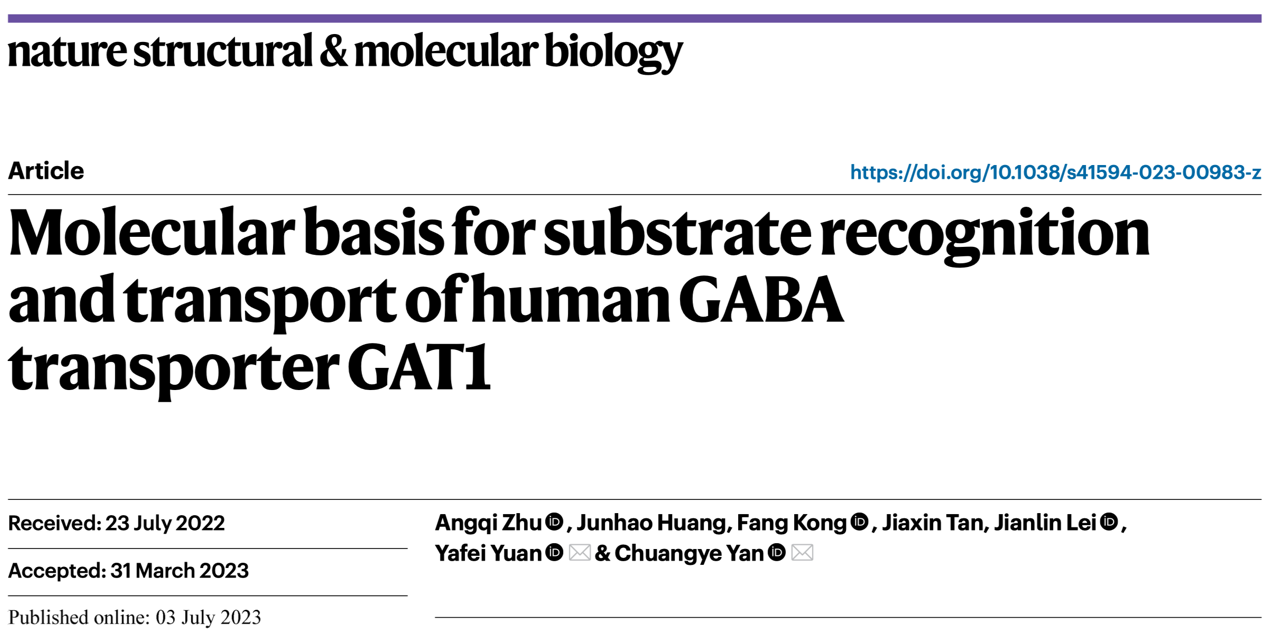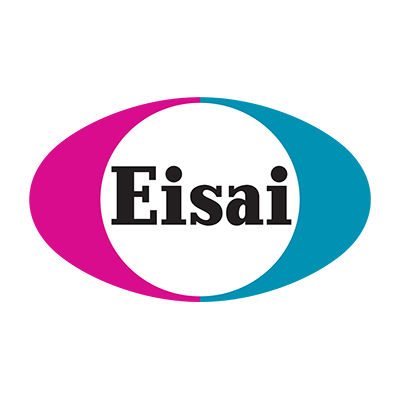预约演示
更新于:2025-05-07
GAT1
更新于:2025-05-07
基本信息
别名 GABA transporter 1、GABATHG、GABATR + [9] |
简介 Mediates transport of gamma-aminobutyric acid (GABA) together with sodium and chloride and is responsible for the reuptake of GABA from the synapse (PubMed:30132828). The translocation of GABA, however, may also occur in the reverse direction leading to the release of GABA (By similarity). The direction and magnitude of GABA transport is a consequence of the prevailing thermodynamic conditions, determined by membrane potential and the intracellular and extracellular concentrations of Na(+), Cl(-) and GABA (By similarity). Can also mediate sodium- and chloride-dependent transport of hypotaurine but to a much lower extent as compared to GABA (By similarity). |
关联
8
项与 GAT1 相关的药物靶点 |
作用机制 GAT1抑制剂 |
在研机构 |
非在研适应症- |
最高研发阶段批准上市 |
首次获批国家/地区 丹麦 |
首次获批日期1996-01-01 |
靶点 |
作用机制 GAT1抑制剂 [+1] |
在研机构 |
原研机构 |
在研适应症 |
非在研适应症 |
最高研发阶段临床前 |
首次获批国家/地区- |
首次获批日期1800-01-20 |
靶点 |
作用机制 GAT1抑制剂 |
在研机构- |
在研适应症- |
非在研适应症 |
最高研发阶段终止 |
首次获批国家/地区- |
首次获批日期1800-01-20 |
20
项与 GAT1 相关的临床试验NCT04676685
A Randomized, Double-Blind, Placebo-Controlled, Multiple-Ascending Dose and Single Dose Food Effect Study to Assess the Safety, Tolerability, and Pharmacokinetics of E2730 in Healthy Subjects
The primary purpose of the study is to evaluate the safety, tolerability, and pharmacokinetics (PK) of E2730 of multiple ascending oral doses in healthy adult participants and to assess the differences in PK, safety, and tolerability of E2730 between healthy Japanese and non-Japanese participants following multiple doses. This study will also determine the effect of food on PK of E2730.
开始日期2020-12-16 |
申办/合作机构 |
NCT03603639
A Multicenter, Double-Blind, Randomized, Cross-Over Study Evaluating Pharmacodynamic Activity of E2730 in Adult Subjects With Photosensitive Epilepsy
The primary purpose of the study is to assess the pharmacodynamic (PD) activity of E2730 as measured by suppression of epileptic photoparoxysmal response (PPR) in the participant's most sensitive eye condition in participants with photosensitive epilepsy.
开始日期2018-07-27 |
申办/合作机构 |
NCT03451890
A Randomized, Double-Blind, Placebo-Controlled, Single Ascending Dose Study to Assess the Safety, Tolerability, and Pharmacokinetics of E2730 in Healthy Subjects
This study will be conducted to evaluate the safety, tolerability, and pharmacokinetics of single ascending oral doses of E2730 in healthy adult participants.
开始日期2018-02-09 |
申办/合作机构 |
100 项与 GAT1 相关的临床结果
登录后查看更多信息
100 项与 GAT1 相关的转化医学
登录后查看更多信息
0 项与 GAT1 相关的专利(医药)
登录后查看更多信息
1,034
项与 GAT1 相关的文献(医药)2025-06-01·Neuropharmacology
Evidence for low affinity of GABA at the vesicular monoamine transporter VMAT2 – Implications for transmitter co-release from dopamine neurons
Article
作者: Limani, Fabian ; Hanzlova, Michaela ; Steinkellner, Thomas ; La Batide-Alanore, Ségolène ; Klotz, Sigrid ; Hnasko, Thomas S ; Srinivasan, Sivakumar
2025-04-18·Current Neuropharmacology
Altered GABAergic Homeostasis in the Striatum of Dopamine Transporter Knockout Rats
Article
作者: Leo, Damiana ; Targa, Giorgia ; Fumagalli, Fabio ; Rizzi, Beatrice ; Caffino, Lucia ; Mottarlini, Francesca ; Gainetdinov, Raul R.
2025-04-01·Journal of Neurochemistry
Careful Examination of a Novel Azobenzene Paroxetine Derivative and Its Interactions With Biogenic Amine Transporters
Article
作者: Holy, Marion ; Sandtner, Walter ; Kickinger, Stefanie ; Mihovilovic, Marko D. ; Schittmayer, Matthias ; Mayer, Felix P. ; Hu, Yuntao ; Belleza, Oliver John V. ; Sitte, Harald H. ; Mikšovsky, Philipp ; Dreier, Dominik ; Hellsberg, Eva ; Schlögl, Katharina ; Ecker, Gerhard F. ; Jäntsch, Kathrin
10
项与 GAT1 相关的新闻(医药)2025-02-20
·生物谷
在当今社会,随着人们健康意识的提升,传统香烟的使用率有所下降。然而,电子烟的兴起却带来了新的问题,尤其是在育龄女性群体中,电子烟的使用呈增长态势。这一现象令人担忧,因为孕期尼古丁暴露(PNE)会严重干扰胎儿的正常发育,与后代的情绪和焦虑障碍等问题密切相关。不过,以往的研究大多依赖临床人群和动物模型,存在一定的局限性,临床研究可能受多种因素干扰,动物实验又因物种差异,难以完全反映人类胎儿的真实情况。
最近,一项发表于Front Pharmacol的研究Chronic nicotine exposure induces molecular and transcriptomic endophenotypes associated with mood and anxiety disorders in a cerebral organoid neurodevelopmental model利用大脑类器官模型,模拟孕期尼古丁暴露环境,深入探究其对神经发育的影响。
从短期影响来看,尼古丁对大脑类器官的作用较为明显。在细胞层面,高剂量(10 μM)的尼古丁显著增加了凋亡细胞死亡标记物CCasp3的表达,同时,早期神经元标记物CTIP2也显著增多。这表明高剂量尼古丁在发育早期具有细胞毒性,不仅导致细胞死亡数量上升,还促使早期神经元数量异常增加,这可能会打乱正常的神经发育进程。
图 1:尼古丁在第42天显著增加细胞死亡和早期生成神经元的数量
在神经递质受体方面,尼古丁表现出选择性的影响。研究发现,并非所有与焦虑和抑郁相关的nAchRs都受尼古丁影响,其中α7 nAchR的表达未发生明显变化,但α4和β2 nAchR亚基的表达显著上升。这种变化可能会影响GABA的释放,进而破坏大脑中与情绪和焦虑相关的神经回路平衡,为情绪和焦虑障碍的发生埋下隐患。
图 2:尼古丁在第42天选择性上调特定的nAchRs
多巴胺受体D1R和D2R的表达也受到尼古丁的影响。在低剂量尼古丁作用下,D1R和D2R的表达显著降低。多巴胺能信号传导在情绪调节中起着关键作用,这一变化意味着尼古丁干扰了正常的多巴胺能信号通路,与情绪和焦虑障碍中蛋白质表达的变化趋势一致。
另外,维持皮质兴奋/抑制(E/I)平衡的GABA能系统也未能幸免。高剂量尼古丁会降低GABA转运体GAT-1、PV中间神经元和GABA合成标记物GAD67的表达。这些变化进一步证实了尼古丁会破坏皮质E/I平衡,而E/I平衡失调正是情绪和焦虑障碍的重要特征之一。
从基因转录角度分析,RNA测序结果显示,0.1 μM尼古丁处理的类器官中有91个基因下调,40个基因上调。这些差异表达基因涉及胚胎发育、神经发生和转录调控等多个重要过程,表明尼古丁对基因表达的影响广泛且深入,从根本上干扰了大脑类器官的正常发育程序。
再看长期影响:当类器官发育到180天(D180)时,之前观察到的一些变化出现了新的发展。例如,CTIP2的表达显著降低,而D1R的表达则显著增加,同时,谷氨酸能受体NR2B和mGLUR2/3的表达也有所上升。这一系列变化表明,神经元分化、多巴胺能和谷氨酸能系统在长期内持续受到尼古丁的影响,进一步改变了大脑的神经功能。
图 3:尼古丁在第180天诱导神经元分化、多巴胺能和谷氨酸能标记物发生长期改变
在基因表达层面,多个与神经和皮质发育相关的标记物出现异常。如TBR1和EOMES的表达下降,暗示着PNE对神经和皮质发育的长期不良影响。此外,GABA能和谷氨酸能基因表达的改变,以及D1R表达呈下降趋势,都进一步说明了PNE对神经递质系统的干扰会持续到神经发育的后期阶段。
图 4:尼古丁在第180天对神经身份标记物、与情绪和焦虑障碍相关的谷氨酸能、GABA 能和多巴胺能标记物产生持续的长期改变
综合来看,这项研究通过大脑类器官模型,清晰地展示了慢性尼古丁暴露对神经发育的广泛而深远的影响。从细胞到分子,从短期到长期,尼古丁干扰了神经发育的多个关键环节,与情绪和焦虑障碍相关的分子表型变化密切相关。这不仅验证了PNE体外模型的有效性,更为我们理解孕期尼古丁暴露导致神经精神疾病的机制提供了重要依据。
对于广大育龄女性而言,这一研究结果无疑是一记警钟。为了宝宝的健康,孕期应坚决避免尼古丁暴露,无论是传统香烟还是电子烟。同时,该研究也为后续开发针对相关神经精神疾病的干预措施和治疗方法指明了方向。期待未来能有更多的研究成果,帮助我们更好地预防和治疗这些由孕期尼古丁暴露引发的疾病,守护下一代的健康成长。
参考文献:
Proud EK, Rodríguez-Ruiz M, Gummerson DM, et al. Chronic nicotine exposure induces molecular and transcriptomic endophenotypes associated with mood and anxiety disorders in a cerebral organoid neurodevelopmental model. Front Pharmacol. 2024;15:1473213. Published 2024 Dec 23. doi:10.3389/fphar.2024.1473213
本文仅用于学术分享,转载请注明出处。若有侵权,请联系微信:bioonSir 删除或修改!
点击下方「阅读原文」,前往生物谷官网查询更多生物相关资讯~
临床研究
2023-12-19
·今日头条
本文为转化医学网原创,转载请注明出处
作者:Jerry
导读:
研究表明,长期睡眠不足会导致免疫功能障碍,并参与肿瘤的发生和发展。然而,睡眠不足和结肠癌之间的关系尚不清楚。
近日,华中科技大学舒晓刚教授团队在期刊《Journal of Experimental & Clinical Cancer Research》发表了题为“GABA induced by sleep deprivation promotes the proliferation and migration of colon tumors through miR-223-3p endogenous pathway and exosome pathway”的研究论文,
本研究探讨了睡眠不足促进结肠癌增殖和迁移的具体机制,重点研究了神经递质GABA。
https://jeccr.biomedcentral.com/articles/10.1186/s13046-023-02921-9#Sec37
研究背景
01
近年来,越来越多的研究证明了睡眠和癌症之间的密切关系。生物钟通过生理的时间调节来维持体内平衡。然而,睡眠节律的中断促进了癌症特征的建立,肿瘤的形成也直接削弱了大脑对节律的控制。癌症患者长期睡眠节律紊乱或睡眠质量差,这可归因于疼痛、化疗副作用甚至抑郁等因素。据报道,睡眠不足会导致各种恶性肿瘤,包括血液肿瘤、肺癌和乳腺癌。
然而,睡眠不足与结肠癌发展之间的具体关系仍未得到充分研究。
原发肿瘤与局部间质成分的相互作用为肿瘤微环境(tumor microenvironment, TME)的远处转移创造了有利条件。外泌体是由细胞分泌的纳米颗粒,促进细胞间的通讯。这些外泌体可以从供体细胞穿越到靶细胞,潜在地促进肿瘤增殖、侵袭、转移和耐药。肿瘤相关巨噬细胞(tam)是TME的主要组成部分。据报道,TAM在实体瘤中的浸润与预后不良有关。值得注意的是,M2样巨噬细胞通过刺激血管生成、增加肿瘤细胞的迁移、侵袭和抑制抗肿瘤免疫来促进癌症的发生和恶性进展。然而,巨噬细胞与结肠癌细胞之间的相互作用机制尚不清楚,外周血中GABA是否影响这种相互作用尚未报道。
研究进展
02
研究人员建立慢性睡眠不足小鼠模型,探讨睡眠障碍对肿瘤的影响。结果显示,睡眠不足组大鼠皮下结肠癌肿瘤体积和重量均增加。此外,在转移小鼠模型中,与正常睡眠组相比,睡眠不足组观察到更多的肺结节和浸润增加。
睡眠不足诱导的GABA通过miR-223-3p内源性途径和外泌体途径促进结肠肿瘤的增殖和迁移
为了进一步阐明睡眠障碍和结肠肿瘤之间的联系机制,研究人员评估了睡眠不足小鼠血清中几种与睡眠相关的神经递质的水平,包括GABA、NE、EPI和5-羟色胺。值得注意的是,睡眠不足组血清中GABA浓度显著升高。研究人员检查了对照组和睡眠不足组的脑蛋白,以确定慢性睡眠不足和GABA表达之间的关系。研究人员检测大鼠大脑和小脑中谷氨酸脱羧酶1 (GAD1)、GABA囊泡转运蛋白(VGAT)和GABA转运蛋白1 (GAT1)的表达。结果显示,睡眠不足组GAD1和VGAT表达升高,表明脑组织GABA合成和转运能力增加。相反,睡眠不足组GAT1表达明显降低。GAT1可以在突触空间重新摄取GABA,这表明睡眠不足在突触区域维持高水平的GABA,从而促进GABA进入外周血。研究人员还观察了GABA对AOM-DSS小鼠模型的影响。这些结果表明,GABA增加了小鼠结肠肿瘤病变的数量。此外,免疫组化染色结果表明,GABA促进了原发性结肠肿瘤的增殖和迁移。
总之,本研究结果表明,睡眠不足通过促进GABA合成和血液进入来促进结肠癌的增殖和迁移。
研究结论
03
总之,本研究发现了睡眠不足通过释放GABA促进结肠癌发生和发展的新机制。在结肠癌细胞内,miR-223-3p通过内源性调控抑制cMYC的泛素化和蛋白酶体降解。此外,miR-223-3p还通过外泌体参与结肠癌细胞与巨噬细胞之间复杂的通讯,进一步促进结肠癌细胞的增殖和迁移。改善睡眠仍然是预防和抑制癌症的首要任务。然而,睡眠的机制是复杂的,睡眠与肿瘤之间的相互影响还需要进一步的探索。根据目前的研究,靶向GABA水平和miR-223-3p表达成为治疗结肠癌和减缓肿瘤进展的潜在治疗策略。此外,需要对GABA和miR-223-3p在TME中的作用进行更深入的研究,以阐明TME中细胞间通讯的精确分子机制。
参考资料:
https://jeccr.biomedcentral.com/articles/10.1186/s13046-023-02921-9#Sec37
注:本文旨在介绍医学研究进展,不能作为治疗方案参考。如需获得健康指导,请至正规医院就诊。
热门·直播/活动
🕓 北京|12月19日-20日
▶第四届单细胞测序技术应用研讨会暨单细胞&空间组学研讨会(日程稍后公布)
点击对应文字 查看详情
2023-07-10
·生物谷
γ-氨基丁酸(GABA)为人体中枢神经系统内重要的抑制性神经递质。在GABA能神经元中,当突触前膜去极化后,内含GABA的突触囊泡将融合到突触前膜,并释放GABA到突触间隙中。随后,GAB
γ-氨基丁酸(GABA)为人体中枢神经系统内重要的抑制性神经递质。在GABA能神经元中,当突触前膜去极化后,内含GABA的突触囊泡将融合到突触前膜,并释放GABA到突触间隙中。随后,GABA会结合突触后膜的GABAA受体,引发Cl-内流,使得突触后膜超极化,从而抑制神经冲动的传递。GABA转运体1(GAT1)负责将突触间隙的GABA回收至突触前膜神经元,从而调控下游受体的激活状态。GAT1维持着神经系统抑制微环路的稳定,其功能异常会导致多种神经类疾病,比如自闭症、癫痫、精神分裂症。GAT1是重要的抗癫痫靶点,通过阻断GAT1的功能可以抑制突触间隙中GABA的清除,进而减少神经冲动以减轻癫痫症状。1997年,美国FDA批准GAT1抑制剂噻加宾作为辅助治疗的癫痫的药物。此前Gati组在2022年报道了GAT1结合噻加宾的3.8埃的电镜结构[1],但是目前仍然缺乏高分辨率的结构信息来揭示GAT1对小分子底物GABA的识别和转运机制以及其它抑制剂如3-哌啶甲酸的抑制机制。
清华大学生命科学学院副教授闫创业课题组在自然-结构与分子生物学(Nature Structural & Molecular Biology)发布了关于GABA转运体GAT1的转运与抑制机制的重要成果。该工作通过结构生物学和生物化学相结合的手段阐明GAT1转运底物GABA的机制,揭示了竞争性抑制剂3-哌啶甲酸和非竞争性抑制剂抗癫痫药物噻加宾的抑制机制,为进一步靶向GATs的药物奠定了基础。
在本篇文章中报道了GAT1在无底物、结合内源底物GABA、竞争性抑制剂3-哌啶甲酸和非竞争性抑制剂抗癫痫药物噻加宾四种不同的结构,分辨率为2.2~3.2埃。其中无底物结合与结合噻加宾的结构为向内开口(inward-open)状态,结合内源底物GABA和竞争性抑制剂3-哌啶甲酸的结构为向内阻塞(inward-occluded)状态(图1)。
图1 GAT1在无底物状态及结合三种配体的结构
低分子量膜蛋白解析在冷冻电镜领域较为困难,一般需要较大可溶区或者纳米抗体的帮助。在此前闫创业课题组成功解析具有柔性可溶区的单羧酸转运体MCT1/Basigin-2复合物(3.0埃)[2]和无可溶区的葡萄糖转运体GLUT4(3.2埃)[3]的高分辨率三维结构。在这项工作中,研究人员在没有纳米抗体的条件下,进一步获得了2.2至2.4埃高分辨率的无底物结合和结合底物GABA的GAT1结构。
得益于高分辨率的电镜密度图,研究人员可以准确地将GABA、3-哌啶甲酸和噻加宾准确地搭建出来(图2),同时在结构中也能清楚地观测到钠离子、氯离子和水分子。GABA和3-哌啶甲酸的羧基可以与钠离子、残基G65和Y140相互作用,而它们的氮原子可以与周围的水相互作用。通过对这些配体与GAT1的相互作用模式的分析,该研究提供了有关GAT1识别和转运底物以及抑制机制的重要见解。这项研究为进一步开发针对GATs的治疗神经疾病的药物提供了有价值的设计思路。
图2 GAT1与GABA、3-哌啶甲酸和噻加宾的互作模式
清华大学生命科学学院副教授闫创业和助理研究员袁亚飞为共同通讯作者;2019级博士生朱盎岐为本文的第一作者;2022级博士生黄隽豪、2021级博士生孔方和2019级博士生谭佳鑫对本研究提供了重要帮助;清华大学冷冻电镜平台主管雷建林博士为冷冻电镜数据收集提供了帮助。
实验的电镜数据采集受到清华大学冷冻电镜平台的支持,实验的计算工作得到清华大学高性能计算平台、国家蛋白质设施实验技术中心(北京)的支持。本研究获得了国家自然科学基金重点研发计划、膜生物学国家重点实验室、北京市科技新星计划、北京高校卓越青年科学家计划项目、北京生物结构前沿研究中心与清华-北大生命科学联合中心的经费支持。

分析
对领域进行一次全面的分析。
登录
或

生物医药百科问答
全新生物医药AI Agent 覆盖科研全链路,让突破性发现快人一步
立即开始免费试用!
智慧芽新药情报库是智慧芽专为生命科学人士构建的基于AI的创新药情报平台,助您全方位提升您的研发与决策效率。
立即开始数据试用!
智慧芽新药库数据也通过智慧芽数据服务平台,以API或者数据包形式对外开放,助您更加充分利用智慧芽新药情报信息。
生物序列数据库
生物药研发创新
免费使用
化学结构数据库
小分子化药研发创新
免费使用



